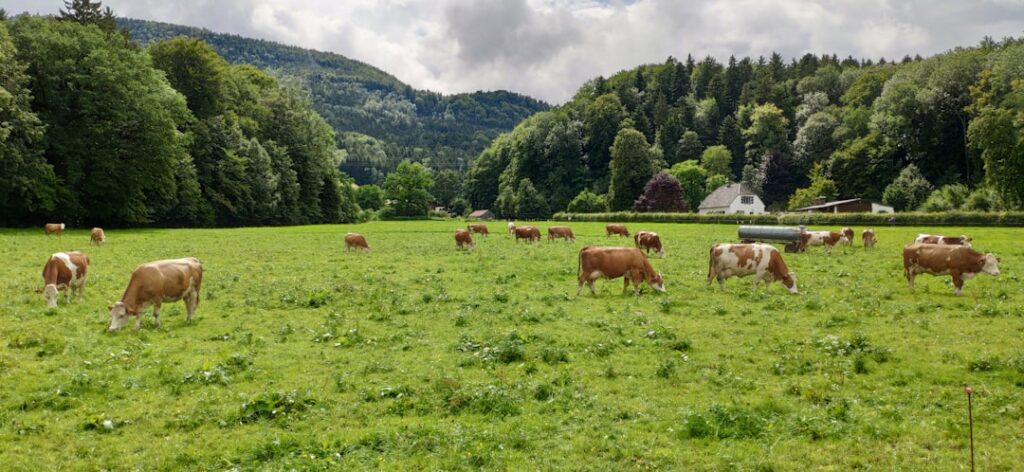Miller and Lux was a prominent and influential company that played a significant role in shaping the history of California’s economy and agriculture. The company was founded by two immigrants, Henry Miller and Charles Lux, who arrived in the United States in the mid-19th century. Both men came from humble beginnings and possessed a strong work ethic and entrepreneurial spirit. They started their business by purchasing a small herd of cattle and began selling meat to the growing population of California during the Gold Rush.
Henry Miller, originally from Brackenheim, Germany, and Charles Lux, from Switzerland, quickly recognized the potential for growth in the cattle industry and expanded their operations. They acquired more land and cattle, eventually becoming one of the largest landowners and cattle ranchers in the United States. Their hard work, strategic business decisions, and innovative farming techniques propelled them to become cattle barons, amassing immense wealth and power in California.
The success of Miller and Lux was a testament to the American Dream, as two immigrants rose from poverty to become influential figures in the development of the American West. Their story is a testament to the opportunities available in the United States for those with determination and vision. The rise of Miller and Lux from immigrant entrepreneurs to cattle barons is a compelling example of the impact of hard work, perseverance, and innovation in shaping the history of American business and agriculture.
Key Takeaways
- Miller and Lux started as immigrant entrepreneurs and rose to become cattle barons in California.
- The impact of Miller and Lux on California’s economy and agriculture was significant, shaping the state’s development.
- The notorious business practices of Miller and Lux led to controversies and conflicts, tarnishing their reputation.
- Miller and Lux expanded their cattle empire by acquiring land and building infrastructure, solidifying their dominance in the industry.
- The enduring legacy of Miller and Lux includes their contributions to California’s history and culture, leaving a lasting impact.
The Impact of Miller and Lux on California’s Economy and Agriculture
Miller and Lux had a profound impact on California’s economy and agriculture during the late 19th and early 20th centuries. The company’s vast land holdings and extensive cattle ranching operations contributed significantly to the state’s economic growth. As one of the largest landowners in California, Miller and Lux played a pivotal role in shaping the development of the state’s agricultural industry.
The company’s innovative farming techniques and large-scale operations helped to modernize and industrialize California’s agriculture. Miller and Lux introduced new methods for cattle ranching, irrigation, and land management that revolutionized the industry. Their influence extended beyond cattle ranching, as they also invested in other agricultural ventures such as wheat farming, fruit orchards, and vineyards.
Furthermore, Miller and Lux’s business activities stimulated economic growth in California by creating jobs, supporting local businesses, and contributing to the state’s tax revenue. The company’s success also attracted other entrepreneurs and investors to California, further fueling the state’s economic expansion. The impact of Miller and Lux on California’s economy and agriculture was far-reaching, leaving a lasting legacy that continues to shape the state’s agricultural industry to this day.
The Notorious Business Practices of Miller and Lux: Controversies and Conflicts
Despite their significant contributions to California’s economy and agriculture, Miller and Lux were also known for their controversial business practices. The company’s aggressive expansion strategies often led to conflicts with smaller ranchers, farmers, and indigenous communities. Miller and Lux were accused of using strong-arm tactics to acquire land, water rights, and grazing privileges, leading to disputes and legal battles with local residents.
Additionally, the company’s large-scale cattle ranching operations had negative environmental impacts, such as overgrazing and depletion of natural resources. These practices led to ecological degradation and conflicts with environmental conservationists. Miller and Lux’s business practices were also criticized for their treatment of workers, as they were known for employing cheap labor and providing poor working conditions on their ranches.
The controversies surrounding Miller and Lux’s business practices tarnished their reputation and led to public scrutiny. However, it is important to acknowledge that their actions were reflective of the prevailing business practices of the time. While their methods may have been contentious, it is undeniable that Miller and Lux played a significant role in shaping the development of California’s agricultural industry.
The Expansion of Miller and Lux’s Cattle Empire: Acquiring Land and Building Infrastructure
| Year | Land Acquired (acres) | Infrastructure Built |
|---|---|---|
| 1871 | 50,000 | First ranch established |
| 1875 | 100,000 | Construction of cattle ranches |
| 1880 | 200,000 | Development of irrigation systems |
| 1885 | 300,000 | Expansion of railroads for transportation |
Miller and Lux’s expansion of their cattle empire was characterized by strategic land acquisitions and the development of extensive infrastructure. The company aggressively purchased vast tracts of land throughout California, Nevada, Oregon, and other western states, amassing over 1.4 million acres at its peak. This land acquisition strategy allowed Miller and Lux to establish a dominant presence in the cattle industry and solidify their position as one of the largest landowners in the United States.
In addition to acquiring land, Miller and Lux invested heavily in building infrastructure to support their cattle ranching operations. They constructed miles of fencing, irrigation systems, barns, and other facilities to manage their vast herds of cattle. The company also developed transportation networks, including railroads and shipping facilities, to transport livestock to markets across the country.
The expansion of Miller and Lux’s cattle empire was a testament to their ambition and vision for growth. Their strategic land acquisitions and investment in infrastructure laid the foundation for their success as cattle barons. The scale of their operations was unprecedented at the time, setting new standards for efficiency and productivity in the cattle industry.
The Enduring Legacy of Miller and Lux: Contributions to California’s History and Culture
The enduring legacy of Miller and Lux is deeply intertwined with California’s history and culture. The company’s impact on the state’s economy, agriculture, and landscape is still visible today. Miller and Lux played a pivotal role in shaping the development of California as a major agricultural powerhouse, contributing to the state’s prosperity and growth.
Furthermore, the company’s influence extended beyond its economic contributions. Miller and Lux left a lasting imprint on California’s cultural heritage through their role in shaping the identity of the American West. Their legacy is reflected in literature, art, and popular culture that romanticizes the era of cattle barons and pioneers. The image of vast open ranges dotted with cattle herds has become an enduring symbol of California’s frontier spirit, perpetuated by the legacy of Miller and Lux.
Moreover, Miller and Lux’s impact on California’s landscape is evident in the preservation of historic ranches, buildings, and landmarks associated with their legacy. These sites serve as reminders of the company’s significant contributions to California’s history and culture. The enduring legacy of Miller and Lux continues to be celebrated as an integral part of California’s rich heritage.
The Decline of Miller and Lux: Challenges and Changes in the Cattle Industry

The decline of Miller and Lux began in the early 20th century as the cattle industry faced new challenges and changes. The company struggled to adapt to shifting market dynamics, technological advancements, and changing consumer preferences. Additionally, environmental concerns related to overgrazing and land degradation posed significant challenges to their operations.
Furthermore, changes in government policies, such as land use regulations and water rights laws, impacted Miller and Lux’s ability to expand their operations. These regulatory changes limited their access to natural resources essential for cattle ranching, further exacerbating their decline.
The decline of Miller and Lux marked a turning point in the history of the American West as it signaled the end of an era dominated by large-scale cattle barons. However, it is important to recognize that their contributions to California’s agricultural industry continue to influence modern ranching practices.
Remembering Miller and Lux: Their Influence on Modern Ranching and Agriculture in California
While Miller and Lux may have experienced a decline in their operations, their influence on modern ranching and agriculture in California is undeniable. The company’s innovative farming techniques, infrastructure development, and large-scale operations set new standards for efficiency and productivity in the cattle industry.
Moreover, Miller and Lux’s legacy continues to inspire modern ranchers who seek to emulate their entrepreneurial spirit, commitment to excellence, and dedication to sustainable land management practices. Their story serves as a reminder of the resilience required to succeed in an ever-changing industry.
In conclusion, Miller and Lux’s rise from immigrant entrepreneurs to cattle barons left an indelible mark on California’s history. Their impact on the state’s economy, agriculture, culture, and landscape is a testament to their enduring legacy. While their business practices may have been controversial at times, there is no denying that Miller and Lux played a pivotal role in shaping the development of California as a major agricultural powerhouse. Their contributions continue to influence modern ranching practices, serving as a reminder of their lasting impact on California’s rich heritage.
One related article to Miller and Lux can be found on The Blog Catalog. This article discusses the history and impact of Miller and Lux, a prominent agricultural and cattle ranching company in the late 19th and early 20th centuries. It delves into the company’s rise to prominence, its influence on the development of the American West, and its eventual decline. The article also explores the legacy of Miller and Lux and its lasting impact on the agricultural industry.
FAQs
What was Miller and Lux?
Miller and Lux was a prominent and successful cattle ranching and meatpacking business in the late 19th and early 20th centuries. It was one of the largest and most influential companies in the American West during that time.
Who were the founders of Miller and Lux?
Miller and Lux was founded by Henry Miller and Charles Lux. Henry Miller was a German immigrant who became known as the “Cattle King of California” and Charles Lux was a Swiss immigrant who partnered with Miller to form the company.
What were the main activities of Miller and Lux?
Miller and Lux primarily focused on cattle ranching, meatpacking, and land development. They owned vast amounts of land and raised cattle for meat production, which they then processed and distributed to various markets.
Where was Miller and Lux based?
Miller and Lux was based in California, with its headquarters located in San Francisco. The company also had operations in other western states such as Nevada, Oregon, and Idaho.
What was the significance of Miller and Lux in the American West?
Miller and Lux played a significant role in the development of the American West, particularly in the expansion of cattle ranching and meatpacking industries. The company’s success and influence helped shape the economic and social landscape of the region during that time.


